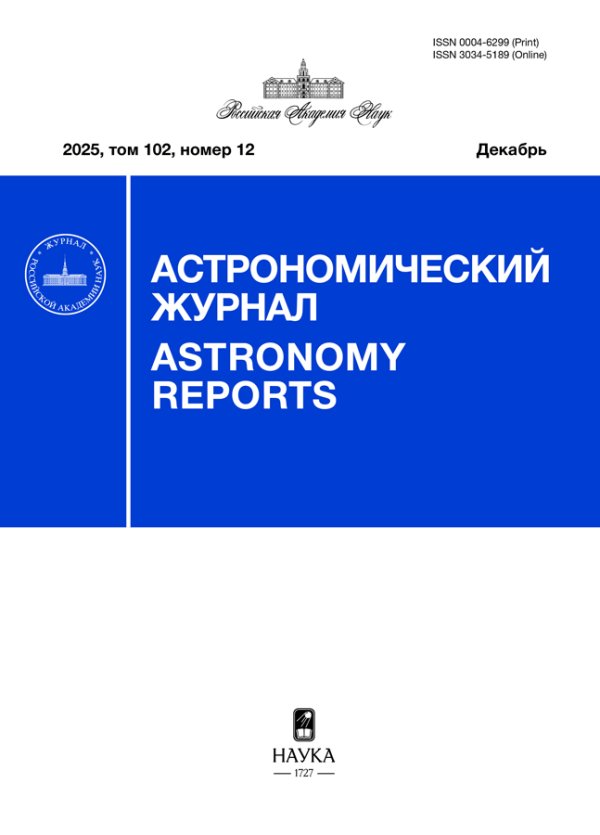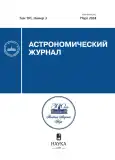Vol 101, No 3 (2024)
Articles
Estimation of the spin of a supermassive black hole in Sagittarius A*
Abstract
In April 2017, the Event Horizon telescope received an image of a supermassive black hole in the Sagittarius A* source. This image consists of a ring-like structure that contains three areas with increased brightness (spots). If we assume that these spots are associated with flares near the event horizon of a black hole, then we can estimate its spin. Our estimate gives a value of the order of a ≈ 0.9.
 208-212
208-212


The role of Biermann battery mechanism in appearance of magnetic fields in accretion discs
Abstract
At present, there is little doubt that accretion discs surrounding compact astrophysical objects such as black holes, white dwarfs and neutron stars may have magnetic field structures. Thus, they explain the transfer of angular momentum between different parts of the disc and some other processes. There are various ways to explain the occurrence of these magnetic fields. In this paper we study the possibility of generation of magnetic fields due to the Biermann battery mechanism. It is associated with radial flows of protons and electrons. Due to their different masses, they interact differently with the rotating medium, producing circular currents that generate magnetic fields. Previously, a similar process was studied for galactic discs and it was shown that the battery mechanism can generate initial magnetic fields in such objects. Here we discuss the action of the Biermann battery for accretion disks. This requires solving an integral equation of the second kind, which arises if we take into account the self-interaction of the magnetic field. It is shown that corresponding fields are quite significant and can play an important role in the evolution of magnetic fields in discs.
 213-221
213-221


Is the young star association ε Cha double?
Abstract
The kinematics of the ε Cha young stellar association close to the Sun has been studied based on a list of candidate stars from the Dickson-Vandervelde work. The working sample consists of 26 stars with parallaxes, proper motions from the Gaia DR3 catalog and radial velocities taken from literary sources. The orbits of the stars back to the past were constructed, and the moment when the association had a minimum spatial size was determined, as well as an analysis of the dependencies of the velocities U, V, W on the coordinates x, y, z was carried out. It is shown that the initial sample is divided into two parts with different kinematic properties. The first sample included 9 stars. Based on the construction of the orbits of these 9 stars, an age estimate of t = 4.9 ± 0.8 million years was obtained. An expansion coefficient in the xz plane with the value Kxz = 135±19 km/s/kpc was also found for them, on the basis of which another age estimate t = 7.2 ± 1.0 million years was obtained. The second sample included 17 stars. The construction of their orbits gave an estimate of age t = 0.2 ± 0.3 million years, and based on the gradient dW/dz = 707 ± 248 km/s/kpc, a second estimate of their age t = 1.4 ± 0.5 million years was obtained. This suggests that the ε Cha association either consists of two groupings of different ages, or a younger one arose as a result of a recent outbreak of star formation within a common star system. The question of the gravitational connection of the groupings has not been considered in the framework of this work.
 222-232
222-232


Probing the ionosphere with pulses from the pulsar B2016+28 at a frequency of 324 MHz
Abstract
Using ground-space VLBI data from the RadioAstron project archive, the phase distortions of the cross-spectrum caused by the ionosphere have been calculated and their influence on the results of determination of the visibility function has been studied. The Arecibo Observatory’s 300-meter antenna served as the ground station for the interferometer. The separation of ionospheric phase distortions from the influence of the interstellar and interplanetary medium and instrumental errors is based on different frequency dependencies of these effects. The amplitude of ionospheric phase variation caused by electron density fluctuations in the ionosphere above the Arecibo radio telescope is several radians per observation session of about one hour. The structure function of phase variations indicates a continuous spectrum of electron density fluctuations at typical times of 2–5 min with no pronounced signs of quasi-periodic processes. Ionospheric phase fluctuations during pulsar observations increase the width of the maximum of the amplitude of the visibility function as a function of the residual interference frequency by 5–10 mHz with a decrease in the value at the maximum of ≈ 10%. When constructing images of radio galaxies and quasars from ground-based VLBI observations, these phase shifts can significantly distort the final results.
 233-243
233-243


Transition from super-alfvenic to sub-alfvenic stellar wind flow passing by an exoplanet, using the example of HD 209458b
Abstract
Depending on the distance of the exoplanet from the central star and on the properties of this star, different regimes of stellar wind flow around it arise. If the exoplanet is at a distance up to the Alfven radius at which the wind speed is equal to the Alfven speed, or the Alfven Mach number MA = 1, then the exoplanet generates Alfven wings. If it is located beyond the Alfven radius, a comet-like magnetosphere appears, like that of the planets of the Solar System. The paper examines how the transition from one flow regime to another can be described on the base of a paraboloid model of the magnetospheric magnetic field using the example of exoplanet HD 209458b.
 244-249
244-249


Principles of the wave dark matter detection in gravitational redshift experiments in the Solar System
Abstract
We explore the possibility of using measurements of the gravitational redshift effect as a means to constrain wave dark matter – a class of models in which the dark matter is accounted for by light scalar particles that behave like classical waves. We construct a mathematical framework that is appropriate for clock comparison experiments with remote clocks and can be used to determine the values of the coupling constants of such dark matter with particles of the Standard Model. Using this framework, we consider an experiment to detect dark matter of the Galactic halo using two satellites equipped with accurate and stable atomic clocks and placed into elliptical heliocentric orbits. We demonstrate that, in most cases, the accuracy of this experiment turns out to be not better than that of ground-based experiments with colocated clocks. The limitation of theaccuracy of the space-based experiment is found to be due to the non-relativistic Doppler compensation system, required when using moving clocks, which decreases the amplitude of the useful signal. Possible solutions to this problem are discussed.
 250-262
250-262


Global families of periodic orbits adjacent to libration points in the restricted three-body problem
Abstract
The restricted circular three-body problem is studied. All global families of periodic orbits adjacent to the libration points are found. A scenario for the evolution of orbits in the family is given. Chains of global families will be highlighted; the chain begins at the triangular libration point, contains global families for the triangular and all collinear libration points, and ends with a family whose orbits are pressed against the main bodies. The evolution of global families in the chain associated with changes in the energy of the system is described. Planar and spatial orbits are studied.
 263-270
263-270


National software for processing information of the satellite – satellite space geodetic system
Abstract
The paper presents the principle of operation, the main components and the results of the work of the software designed for processing large amounts of space geodetic information created at SAI MSU. The developed PC was used to process inter-satellite measurements of a space constellation intended to measure the parameters of the Earth’s gravitational field (EGF). The experimental option of the software enables working with both simulated data and real data of GRACE and GRACE-FO missions. This experimental version was used to recover the EGF parameters on real GRACE and GRACE-FO mission data. Solutions were developed for every month within the measurement periods of 2010 and 2021, as well as for extended periods of 4.3 years and 7.6 years. A comparison of the obtained solutions with the results of the EGF recovering obtained by other researchers is presented.
 271-283
271-283


Displacement norm in the presence of an inverse-square perturbing acceleration in the reference frame associated with the radius vector
Abstract
The problem of motion of a zero-mass point under the influence of attraction to the central body and a small perturbing acceleration P′ = P/r 2 is considered, where r is the distance to the attracting center, components of the vector P are assumed to be constant in a reference system with axes directed along the radius vector, the transversal and the angular momentum vector. Previously, for this problem, we found equations of motion in the mean elements and formulas for the transition from the osculating elements to the mean elements in the first order of smallness; we neglected second-order quantities. In this work, the Euclidean (root–mean–square over the mean anomaly) displacement norm ||dr||2 is obtained, where dr represents the difference between the position vectors on the osculating and mean orbit. It turned out that ||dr||2 depends only on the components of the vector P (positive definite quadratic form), the semi–major axis (proportional to the second power) and the eccentricity of the osculating ellipse. The norm ||dr||2 is obtained in the form of series in powers of the and in powers of the eccentricity e. The results are applied to the problem of the motion of asteroids under the influence of a perturbing acceleration inversely proportional to the square of the heliocentric distance, in particular, under the influence of the Yarkovsky effect.
 284-296
284-296












